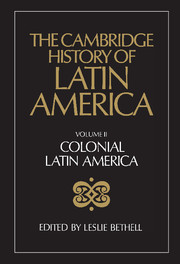Book contents
- Frontmatter
- PART ONE POPULATION
- PART TWO ECONOMIC AND SOCIAL STRUCTURES: SPANISH AMERICA
- 3 The urban development of colonial Spanish America
- 4 Mining in colonial Spanish America
- 5 The formation and economic structure of the hacienda in New Spain
- 6 The rural economy and society of colonial Spanish South America
- 7 Aspects of the internal economy of colonial Spanish America: labour; taxation; distribution and exchange
- 8 Social organization and social change in colonial Spanish America
- 9 Women in Spanish American colonial society
- 10 Africans in Spanish American colonial society
- 11 Indian societies under Spanish rule
- PART THREE ECONOMIC AND SOCIAL STRUCTURES: BRAZIL
- PART FOUR INTELLECTUAL AND CULTURAL LIFE
- Bibliographical essays
- References
3 - The urban development of colonial Spanish America
from PART TWO - ECONOMIC AND SOCIAL STRUCTURES: SPANISH AMERICA
Published online by Cambridge University Press: 28 March 2008
- Frontmatter
- PART ONE POPULATION
- PART TWO ECONOMIC AND SOCIAL STRUCTURES: SPANISH AMERICA
- 3 The urban development of colonial Spanish America
- 4 Mining in colonial Spanish America
- 5 The formation and economic structure of the hacienda in New Spain
- 6 The rural economy and society of colonial Spanish South America
- 7 Aspects of the internal economy of colonial Spanish America: labour; taxation; distribution and exchange
- 8 Social organization and social change in colonial Spanish America
- 9 Women in Spanish American colonial society
- 10 Africans in Spanish American colonial society
- 11 Indian societies under Spanish rule
- PART THREE ECONOMIC AND SOCIAL STRUCTURES: BRAZIL
- PART FOUR INTELLECTUAL AND CULTURAL LIFE
- Bibliographical essays
- References
Summary
THE URBAN IDEA
Like much of Spanish American colonial history, the region's urban development has two prehistories: one indigenous, the other peninsular Spanish. The conquistadores found many populous urban centres in Mesoamerica and, less markedly, in the central Andes. The Aztec capital of Tenochtitlán, with at least 150,000 and perhaps 300,000 inhabitants, became a Spanish viceregal capital. Eight more cities surrounded Lake Texcoco, while outlying centres of regional importance included Cholula, Tlaxcala, Tzin Tzun Tzan, Cempoala, and various sites in Yucatán and Guatemala. In the Inca realm the capital at Cuzco, while lacking the commercial importance of Tenochtitlán, had more than 100,000 inhabitants and exercised political sway over various centres along the Incaic camino real, some of pre-Incaic origin: Quito, Cajamarca, Jauja, Vilcas, Huánuco, and Bonbón. These urban hierarchies, in turn, were successors to earlier settlement complexes oriented towards centres at Teotihuacán, Monte Albán, Taj´n, the Maya cities, Chan Chan, and Tiahuanaco.
Although the Spaniards converted some Indian cities like Tenochtitlán, Cholula, and Cuzco to their own uses, more pervasive influences on the European settlement scheme were the spatial distribution and village structure of the Indian populations. Indeed, if one were to carry the urban history of Spanish America only up to the late sixteenth century, the continuities with pre-conquest society would deserve a dominant emphasis. On a longer view, however, the political, social, and economic determinations of European rule, taken with the detribalization, relocation, and severe mortality of the Indian population, introduced many new vectors of change.
- Type
- Chapter
- Information
- The Cambridge History of Latin America , pp. 65 - 104Publisher: Cambridge University PressPrint publication year: 1984
References
- 6
- Cited by



